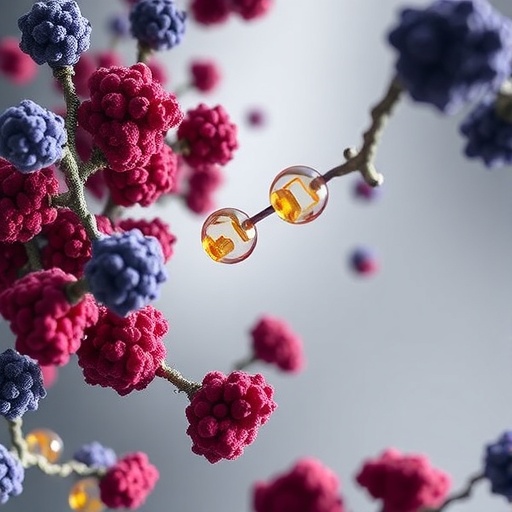In a groundbreaking study poised to reshape our understanding of kinase regulation, researchers have unveiled the remarkable ability of small-molecule inhibitors to dramatically accelerate the degradation of the kinase RIPK2 by hijacking native cellular proteolytic pathways. This discovery not only deepens insight into the intricate mechanisms of protein quality control but also opens exciting therapeutic avenues for targeting inflammatory and infectious diseases where RIPK2 plays a pivotal role.
RIPK2, a cytoplasmic kinase integral to host defense, functions as a critical link between the intracellular pattern recognition receptors NOD1/NOD2 and downstream signaling cascades responsible for bacterial pathogen clearance. Despite its importance, direct modulation of RIPK2’s activity via kinase inhibition has yielded limited clinical benefit, prompting scientists to explore alternative strategies that exploit regulation at the level of protein stability rather than enzymatic activity.
The team began their exploration by screening a comprehensive panel of kinase inhibitors to identify compounds capable of inducing selective degradation of endogenous RIPK2. Among nine candidates that appeared to destabilize RIPK2, one inhibitor termed RI-4 emerged as the most potent and selective agent. In vitro binding assays confirmed direct engagement of RI-4 with recombinant RIPK2, strongly indicating a degradation mechanism linked to compound binding rather than off-target toxicity.
A key feature of RI-4-stimulated RIPK2 degradation was its reliance on protein turnover rather than transcriptional downregulation. This was convincingly demonstrated through the use of flow cytometry–based reporters and immunoblots that tracked loss of RIPK2 protein over time in human cancer cell lines engineered for inducible Cas9 expression. The selectivity of RI-4 was further validated by quantitative proteomics profiling, revealing minimal off-target degradation effects across the kinome.
To decipher the underlying cellular machinery orchestrating RI-4-promoted RIPK2 degradation, the investigators performed a genome-wide CRISPR–Cas9 knockout screen based on fluorescence-activated cell sorting. This unbiased approach uncovered a critical dependency on lysosomal degradation pathways, refuting involvement of the proteasome in this process. Several components associated with macroautophagy, including the essential autophagy mediator FIP200, were identified as indispensable for the degradation cascade, highlighting autophagy rather than proteasomal pathways as the primary route for RIPK2 clearance.
Intriguingly, pharmacological blockade of lysosome acidification using Bafilomycin A1 effectively rescued RIPK2 protein levels after RI-4 treatment, reinforcing the lysosomal degradation hypothesis. Further mechanistic studies showed that RIPK2 assembled into discrete intracellular foci or “RIPosomes” shortly after RI-4 exposure. These multimers depended on the presence of RIPK2’s caspase recruitment domain (CARD), a motif central to physiological activation of RIPK2 signaling and aggregation under stress conditions.
The RI-4–induced RIPK2 puncta exhibited dynamic clearance that was significantly inhibited when lysosomal function was disrupted. This phenomenon mirrors the cell’s natural response to microbial pathogen stimulation, reinforcing the notion that RI-4 exploits a native proteolytic circuit to promote RIPK2 turnover by mimicking infection-triggered assembly and degradation processes. Advanced live-cell microscopy and orthogonal fluorescent reporters confirmed co-localization of these higher-order complexes, giving direct visual evidence of RI-4-induced multimerization.
To characterize proteins associating with these RIPosomes, the researchers employed proximity biotinylation (BioID) proteomics over time courses capturing early and late assembly states. Gene ontology analyses enriched for ubiquitin system components revealed prominent Lys63-linked ubiquitination as a hallmark modification facilitating recognition and clearance of RIPK2 complexes. Notable interactors included deubiquitinases such as TNFAIP3 and CYLD, as well as autophagy receptor SQSTM1/p62, implicating ubiquitin-dependent selective autophagy in this degradation pathway.
Importantly, two E3 ubiquitin ligases containing inhibitor of apoptosis protein (IAP) domains—cIAP1 and XIAP—were enriched proximal to RIPK2 after RI-4 treatment. Genetic ablation of both ligases impaired degradation, demonstrating their redundant yet essential roles in tagging RIPK2 for autophagic destruction. Mutations in RIPK2 disrupting IAP binding phenocopied this effect, further substantiating the functional importance of these ligases in mediating ubiquitin-dependent turnover.
A key mediator uncovered in this study was TMUB1, a ubiquitin-like (UBL) domain-containing protein previously unlinked to RIPK2 regulation. Although TMUB1 did not surface in BioID datasets, targeted depletion experiments revealed its role as an early facilitator of RIPK2 multimerization and degradation. Loss of TMUB1 delayed RIPK2 foci formation and subsequent clearance, and biochemical assays confirmed direct drug-induced interactions between TMUB1 and RIPK2, cementing its role in the assembly process.
Collectively, these findings illustrate an elegant model in which RI-4 induces aberrant higher-order RIPK2 multimerization facilitated by TMUB1, mimicking physiological signal-induced “RIPosome” formation. This assembly is then recognized and ubiquitinated primarily via cIAP1 and XIAP ligases, designating it for macroautophagic degradation. The study reveals a nuanced modulation of kinase stability through native proteolytic circuits that can be pharmacologically exploited to reshape immune signaling.
The implications of this work extend beyond RIPK2 biology, signaling a paradigm shift by demonstrating how selective small-molecule compounds can supercharge kinase turnover rather than merely inhibiting catalytic activity. This opens fresh avenues for targeting kinases involved in a range of pathologies, particularly inflammatory and infectious diseases where controlled protein destruction may be therapeutically advantageous.
By integrating multidisciplinary approaches including chemical biology, CRISPR screening, proteomics, and advanced imaging, the research offers an unprecedented glimpse into the drug-induced remodeling of native protein homeostasis networks. Future endeavors will likely explore whether similar mechanisms apply to other cancer-relevant kinases and how this knowledge can be harnessed to design next-generation degraders with superior selectivity and efficacy.
In summary, the study illuminates a sophisticated interplay between kinase small-molecule inhibitors and cellular proteolytic systems, invigorating RIPK2 for rapid lysosomal turnover through TMUB1-facilitated multimerization and ubiquitin-dependent macroautophagy. This elegant manipulation of the cell’s intrinsic quality control machinery portends transformative possibilities for therapeutic kinase targeting strategies.
Subject of Research: RIPK2 kinase degradation and regulation via inhibitor-induced multimerization and macroautophagy.
Article Title: Inhibitors supercharge kinase turnover through native proteolytic circuits.
Article References:
Scholes, N.S., Bertoni, M., Comajuncosa-Creus, A. et al. Inhibitors supercharge kinase turnover through native proteolytic circuits. Nature (2025). https://doi.org/10.1038/s41586-025-09763-9
DOI: https://doi.org/10.1038/s41586-025-09763-9




